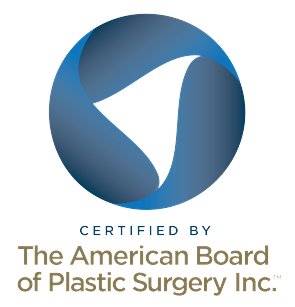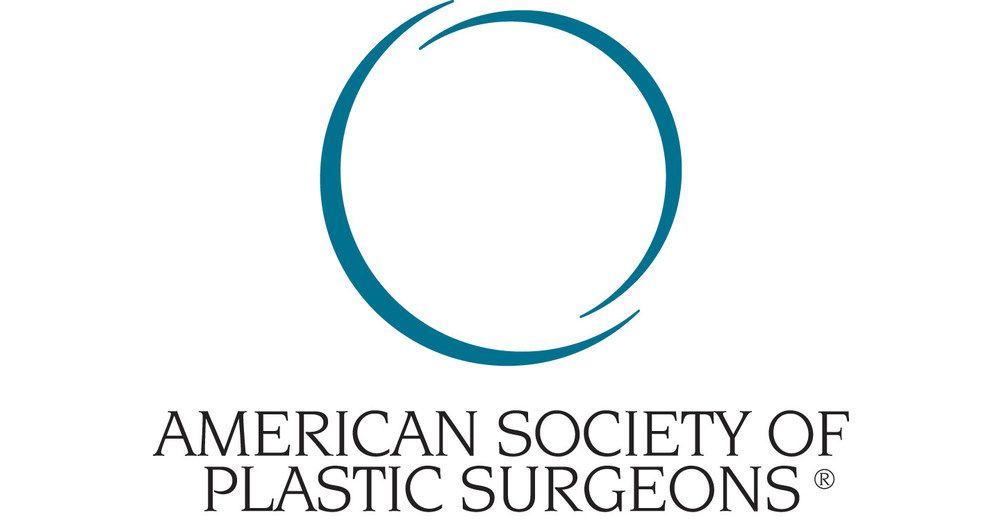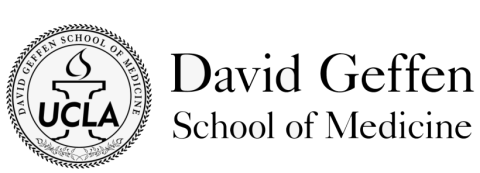BREAST RECONSTRUCTION SURGERY TORRANCE
THE PREFERRED BREAST RECONSTRUCTION &
REVISION SPECIALIST OF TORRANCE
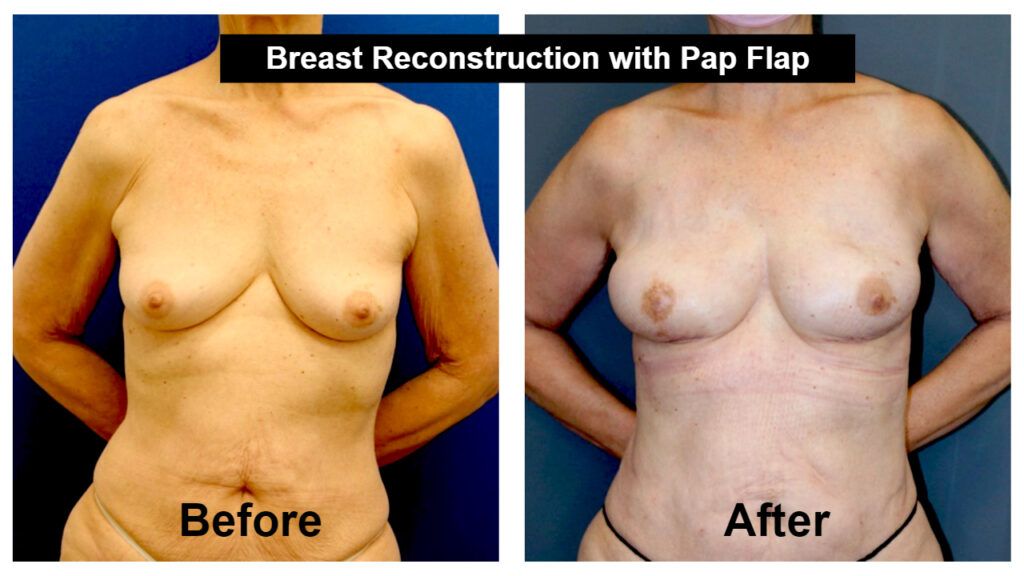
WHY CHOOSE DR. GOLDBERG AS YOUR BREAST RECONSTRUCTION SURGEON?
As a board-certified plastic surgeon, Dr. Goldberg is passionate about providing women with the most cutting-edge breast reconstruction procedures available. She uses the most up-to-date microsurgery methods as a plastic and reconstructive surgeon in Torrance to achieve natural results and fully restore your pre-mastectomy breast shape. Whatever stage of the process you are in or the kind of reconstruction you want in Torrance, Santa Monica, or the greater Los Angeles geographical area, Dr. Goldberg is looking forward to improving your mental and physical well-being so you can feel beautiful and confident.
AM I A CANDIDATE FOR BREAST RECONSTRUCTION?
Candidates in Torrance, Santa Monica, and the greater Los Angeles area for breast reconstruction surgery may have:
- Had a lumpectomy or mastectomy for breast cancer
- Had a prophylactic mastectomy as a result of an inherited genetic mutation (BRCA1 or BRCA2 gene) that predisposes an individual to breast cancer.
- Breast reconstruction following breast explantation because of BII or Breast Implant Illnesses
- Congenital breast deformities that they would like to correct
While mastectomy-related breast reconstruction is the most typical case, transgender patients can also be suitable candidates for the procedure. They may be able to affirm their true selves through this procedure, and their appearance will more closely reflect who they are.
BREAST RECONSTRUCTION PATIENTS SHOULD HAVE:
- Have a positive outlook of restoring their breasts
- Know the capabilities and limitations of the procedure
- Be free of any additional illnesses that could complicate the procedure
- There is no requirement for additional cancer treatments prior to undergoing this procedure

A WOMAN IS STRONGLY MOTIVATED IN HER FIGHT AGAINST BREAST CANCER BY KNOWING THAT SHE HAS OPTIONS FOR BREAST RECONSTRUCTIONS.
WHAT HAPPENS AT A TORRANCE BREAST RECONSTRUCTION CONSULTATION?
Your concerns about the condition of your breasts and your surgical objectives will be covered during your initial Torrance plastic surgery consultation with Dr. Goldberg. She will discuss your breast reconstruction options after assessing your health and looking at your breasts. She will then offer suggestions for your course of treatment and work with you to determine what is best for you.
To create a surgical plan that is oncologically sound, Dr. Goldberg might collaborate with your oncologist or oncologists. This guarantees that your breast reconstruction in Torrance and the surrounding areas of Los Angeles will not only be emotionally empowering and aesthetically pleasing, but will also be supportive of your general health.
HOW IS BREAST RECONSTRUCTION SURGERY PERFORMED?
Using the most up-to-date microsurgical methods, Dr. Goldberg offers a wide range of breast reconstruction procedure options. Women can be inspired to fight breast cancer and all other breast deformities by being knowledgeable of their breast reconstruction options.
Breast reconstruction can be carried out in one stage (surgery) concurrent with mastectomy or in two or more stages requiring multiple surgeries. Patients also have the choice of delayed reconstruction, which allows them to have treatment to restore their breasts at a later date, often after their cancer treatments are over.
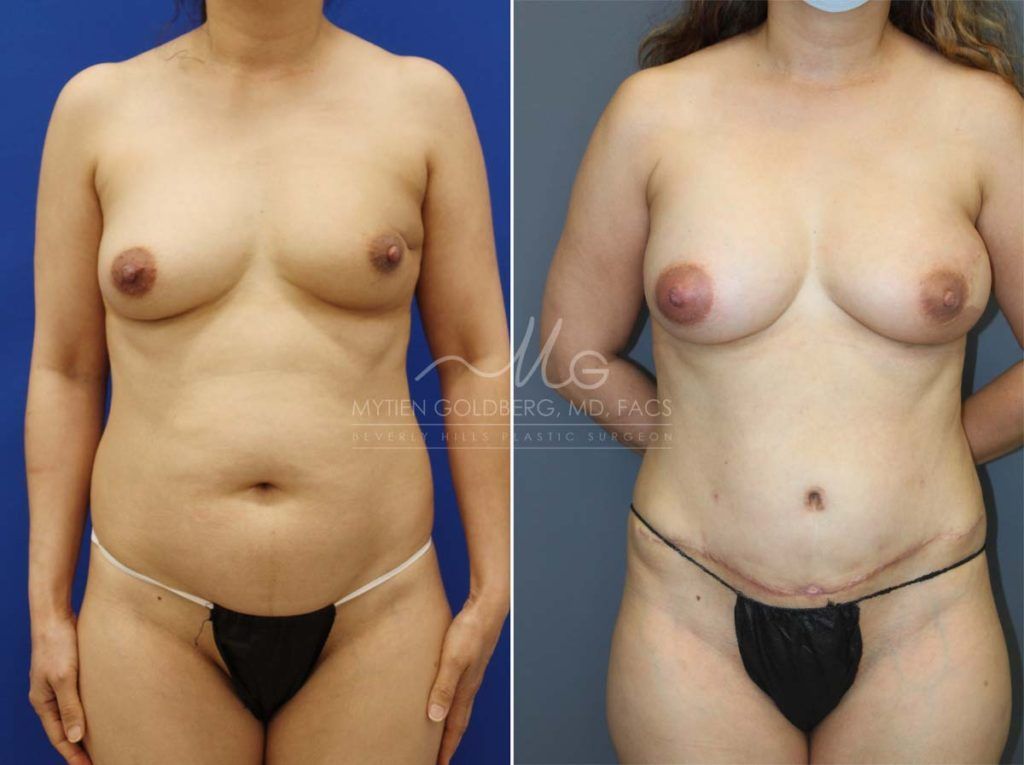
*Individual Results May Vary
CASE STUDY
DESCRIPTION:
48-year-old female with a history of left breast cancer. She underwent radiation and a lumpectomy for left breast cancer.
The patient was frustrated with the significant pain and asymmetrical breasts caused by the lumpectomy deformity.
SURGERY:
- DIEP flap reconstruction of left breast lumpectomy defect using abdominal tissue.
- Breast augmentation on the right breast to achieve symmetry
WHAT TO EXPECT FOLLOWING YOUR BREAST RECONSTRUCTION
Dr. Goldberg and her staff will give you thorough post-care instructions after your procedure. You can contact the team directly at the number provided if you have any questions about your recovery period.
Your incisions will be covered with gauze or bandages following the procedure. This will lessen swelling and add support to the breast(s) that were reconstructed during your healing process. As you recover, a tiny tube may be inserted under your skin to drain any extra fluid.
Depending on the reconstructive techniques used, the majority of patients stay in the hospital for 1 to 3 days. Patients can typically resume their jobs four weeks after a breast reconstruction.
After their reconstructive procedure, patients might experience pain and swelling in the treated area for a few days. Painkillers can reduce discomfort and make bruising, irritation, and swelling more tolerable.
Dr. Goldberg will give you detailed instructions on how to care for your breasts after surgery, take medications, and spot specific problems. The breast reconstruction recovery process will last several weeks as swelling subsides and the breast shape and position settle. Patients must continue to adhere to recovery guidelines and show up for follow-up appointments.
SPECIFIC CARE
After your procedure, you must have someone to drive you from the facility to your home. You cannot drive a vehicle on your own (this includes riding a taxi or any public transportation). You cannot be left alone once you get home; an adult must stay with you for at least 24 hours after you are discharged from the facility.
- You should consume a substantial amount of fluids to aid your body in flushing out the anesthetics used during surgery.
- For the first 1–3 days after surgery, your body might tolerate eating bland, low-sodium foods the best. You need to eat more than just crackers and juice. You can get a list of foods you are recommended to eat from Dr. Goldberg’s staff.
- Refrain from drinking any alcoholic drink for at least the first two weeks and while taking painkillers.
- Only take the medications that Dr. Goldberg has prescribed for your post-operative care, and make sure to read the label on the bottle carefully.
DRESSINGS
- Dressings must be kept dry and clean. Dr. Goldberg will let you know when it is already safe to remove them.
PHYSICAL ACTIVITY
- Restricting your activity for the first 48 hours will help your body heal properly.
- For ten days, refrain from lifting, pulling, or pushing.
- If you have undergone facial surgery, avoid lowering your head below your waist.
- It is required that you stay within a reasonable driving distance of the office for about ten days.
- If given the all-clear, you may take a shower.
- Please wait four weeks after surgery before using the hot tub or bathtub.
- Avoid smoking for the first three weeks following surgery as it will only slow the healing process.
- Driving is permitted once the following requirements have been met: three days following anesthesia, 24 hours following the last painkiller, and when there is no pain when doing an activity (there is a need for you to be able to react quickly).
- Following surgery, you can resume cardio exercises (like walking) seven days later, but only after Dr. Goldberg gives the all-clear.
SCARRING
- Scarring is a common side effect of surgery and can last up to a year before it fades.
- Use sunscreen with an SPF of 25 or higher to protect the tissues in the area.
- Scar gel can be applied after the incisions have healed completely.

TYPES OF BREAST RECONSTRUCTION
The breasts can be reconstructed using one or more techniques. These options consist of:
- Tissue expander and implant reconstruction
- Implant reconstruction
- Hybrid reconstruction (tissue flap and implants)
- Autologous flap reconstruction (using your own tissue)
1-STAGE IMPLANT RECONSTRUCTION: DIRECT-TO-IMPLANT
Modern breast reconstruction methods like direct-to-implant (DTI) combine mastectomy and reconstruction into a single procedure. In this procedure, Dr. Golberg places a silicone gel breast implant right after a breast cancer surgeon has removed the breast tissue with a mastectomy. Dr. Goldberg applies mesh products (acellular dermal matrix) to aid in the regenerative process of the tissue.
For those women who can have mastectomies without removing the nipple and those with early-stage breast cancer, DTI breast reconstruction is the best option. DTI breast reconstruction is extremely advantageous for attaining a faster return to a healthy body image. This is due to the simplicity of the procedure, which also avoids multiple surgeries and recovery times.
2-STAGE IMPLANT RECONSTRUCTION: TISSUE EXPANDER
The 2-stage breast reconstruction technique reconstructs breasts after a mastectomy using 2 surgeries (stages). First, the breast tissue is removed by the surgeon performing the mastectomy. Dr. Goldberg will reshape the breasts during the same surgical procedure by inserting a tissue expander (a balloon-like device) directly into the breast pocket. This is comparable to DTI reconstruction, with the exception that a tissue expander rather than a long-term implant is initially inserted.
The tissue expander will be taken out and replaced with long-lasting silicone breast implants during the second stage.
Patients usually opt for minor adjunct procedures, such as:
- Capsulotomy or opening of the capsule
- Capsulorrhaphy or tightening of the capsule);
- Fat grafting or fat injections
- Removal of extra skin
For patients who want larger breasts than their natural size, the 2-stage method of breast reconstruction is ideal. This is because, during the final stage of the reconstruction, the tissue expander enables stretching of the skin of the breast and the placement of larger implants.
PREPECTORAL IMPLANT RECONSTRUCTION TECHNIQUE
Prepectoral breast reconstruction can involve a single stage or two stages of implant placement. Traditionally, implant reconstruction involves submuscular placement, which involves placing the implant or tissue expander entirely beneath the chest muscle or partially beneath the muscle and an acellular dermal matrix (dual-plane placement). After surgery, this can cause excruciating pain and animation deformities.
Dr. Golberg will use an acellular dermal matrix mesh to fully support the implant and place it beneath the mastectomy skin flap but just above the muscle. This lessens postoperative pain by maintaining the pectoralis major muscle’s and chest wall’s functional integrity.
DIEP FLAP RECONSTRUCTION
The DIEP flap technique uses the patient’s abdominal tissue to reconstruct the breast. In order to rebuild the breast, skin, fat, and blood vessels (perforators) from the lower abdomen’s deep inferior epigastric perforator (DIEP) artery are transferred to the chest. Since no muscle is cut or removed during DIEP flap reconstruction, recovery time and the chance of losing abdominal muscle strength are decreased.
Since the results are comparable to those of a tummy tuck, a DIEP flap is the best option for women who want to have a more flat and lean stomach area. The navel is reshaped and the remaining tissue is smoothened over the abdomen after the donor tissue has been removed. A horizontal scar across the hips may result from a DIEP flap, but it can be easily concealed by clothing below the bikini line.
PAP FLAP RECONSTRUCTION
One of the most cutting-edge methods of breast reconstruction used today is the profunda artery perforator (PAP) flap. It makes use of the profunda artery perforator blood vessel, inner thigh skin, and fat tissue. Modern microsurgery reconstructs the breast by rejoining the blood vessel and thigh tissue to the chest.
When a patient lacks sufficient abdominal fat for a DIEP flap, the PAP flap is the best option. A PAP flap is also a good option for patients who want to have an implant-free, entirely natural breast reconstruction.
One of the pioneers in introducing the PAP flap to patients in Los Angeles, California, was Dr. Goldberg (one of the leading reconstructive surgeons). As of late, it has risen to the top of her practice’s list of breast reconstruction procedures.
EXTENDED ABDOMEN FLAP (LOVE HANDLE TISSUE) RECONSTRUCTION
SGAP FLAP (BUTTOCK TISSUE) RECONSTRUCTION
An SGAP flap reconstructs the breast using the superior gluteal artery perforator blood vessel, skin, and fat from the upper buttocks and hips. In order to ensure the survival of the skin and fat tissue, Dr. Goldberg carefully reattaches the blood vessels of the flap to blood vessels in your chest using microsurgery.
The SGAP flap method is ideal for patients who want a tighter, more lifted buttock because the skin and fat are removed in the same way with a buttock lift. Women who lack enough abdominal tissue for a DIEP TRAM, or SIEA flap are ideal candidates for an SGAP flap. The SGAP flap leaves a tiny scar near the top of your buttocks that is easily hidden by a swimsuit or underwear.
HYBRID: DIEP FLAP AND IMPLANT RECONSTRUCTION
A breast implant and a DIEP flap are combined in a hybrid breast reconstruction to give your breasts the volume and shape they once had. Compared to a breast reconstruction that solely relies on implants or tissue, this technique has a number of benefits. The autologous DIEP flap covers the implant with soft tissue, resulting in results that look natural and lowering the possibility of implant undulating through the skin. Additionally, because the implant can provide enhanced breast volume and projection, the newly created breast size is not constrained to the tissue volume produced from the donor site.
It is possible for candidates for hybrid breast reconstruction to have a small amount of extra abdominal tissue that can be augmented by an implant. This procedure uses healthy, non-radiated tissue from the abdomen, making it advantageous for those who still need radiation after a mastectomy. One of the few highly skilled reconstructive surgeons in the country who provides this breast reconstruction option is Dr. Goldberg.
DELAYED BREAST RECONSTRUCTION
One-stage (immediate) breast reconstruction is carried out concurrently with mastectomy for some patients. But after a mastectomy or lumpectomy, a delayed breast reconstruction can be done weeks, months, or even years later.
Patients may want to postpone reconstruction due to a medical condition, their current stage of breast cancer, or a personal lifestyle preference. Delaying breast reconstruction allows patients to continue receiving cancer treatment without disrupting the already-reconstructed breast (s).
It is never too late to seek breast reconstruction, regardless of how long you put off thinking about it. According to Dr. Goldberg, every woman should have access to breast reconstruction that meets her aesthetic needs and promotes her emotional health.
TRANSGENDER PATIENT BREAST RECONSTRUCTION
Patients suffering from gender dysphoria can start to feel better through gender-affirming surgery known as transgender breast reconstruction. The two main types of transgender breast procedures are top surgeries from male to female (MTF) and female to male (FTM).
Breast reconstruction technologies allow feminization of the chest in male to female breast reconstruction. Contrary to popular belief, breast augmentation in cisgender women is very dissimilar from breast construction for transgender women. Dr. Goldberg uses specialized techniques to meet your aesthetic needs because she is an expert who is aware of the distinctive variations in the chest anatomy.
Using your own tissue, Dr. Goldberg can reconstruct your breast to its original shape.

USING YOUR OWN TISSUE, DR. GOLDBERG CAN RECONSTRUCT YOUR BREAST TO ITS ORIGINAL SHAPE.
WHAT IS REVISION BREAST RECONSTRUCTION?
Patients who are dissatisfied with the results of their initial breast reconstruction can get a revision procedure from Dr. Goldberg. Patients may find that breast implant or tissue flap complications have altered the volume, shape, or symmetry of their breasts.
A capsulectomy, an implant replacement, and/or any additional procedures may be used during revision breast reconstruction to address complications arising from the initial procedure. The results of your revision breast reconstruction may be more aesthetically pleasing, satisfying, and harmonious than those of your initial reconstruction.
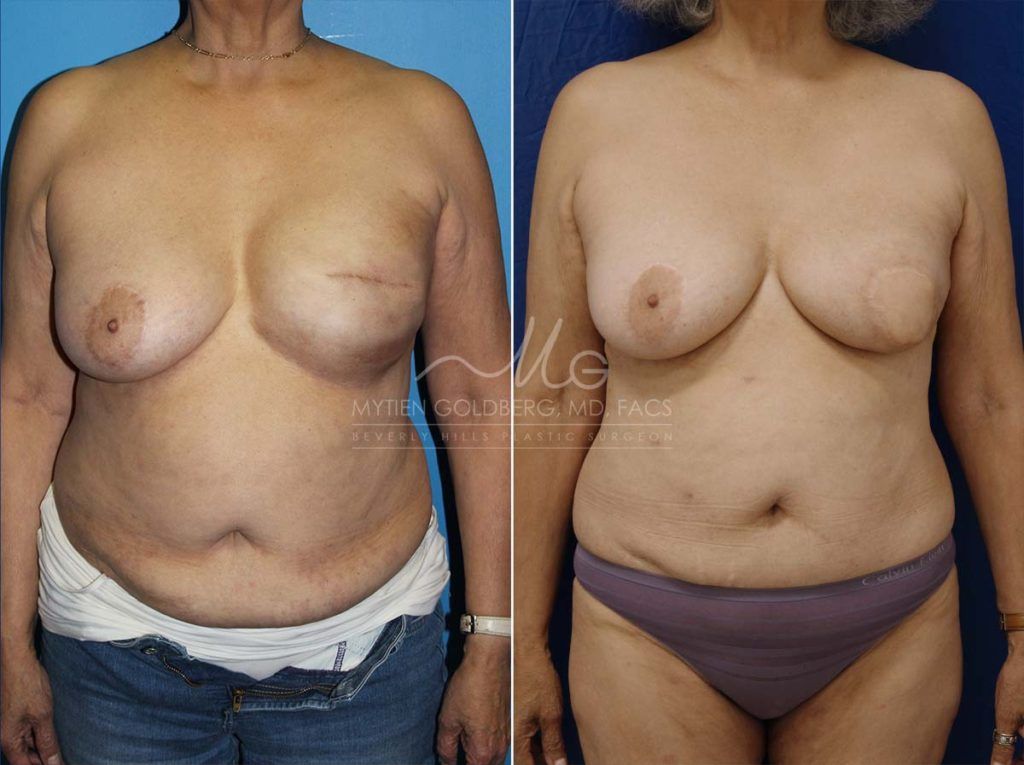
*Individual Results May Vary
CASE STUDY
DESCRIPTION:
68-year-old woman came to see Dr. Goldberg for a revision of her breast reconstruction.
The patient was dissatisfied with the significant pain and asymmetrical breasts caused by the lumpectomy deformity.
SURGERY:
Removing the left breast implant On the chest, the pectoralis major muscle was repositioned. To provide fresh, healthy tissue and to place a new implant for hybrid reconstruction
(latissimus dorsi myocutaneous flap plus an implant), Dr. Goldberg performed a latissimus dorsi myocutaneous flap.
RESULTS:
The patient is happy and her pain is gone.
TORRANCE BREAST RECONSTRUCTION & PLASTIC SURGERY: FREQUENTLY ASKED QUESTIONS
HOW MUCH DOES BREAST RECONSTRUCTION COST IN TORRANCE?
The scope of the reconstruction and the technique(s) used will determine the total cost of the breast reconstruction procedure. The price of breast reconstruction will also depend on additional factors like prescription drugs, facility fees, anesthesia costs, and medical imaging
WILL MY INSURANCE COVER BREAST RECONSTRUCTION SURGERY IN TORRANCE?
Health insurance providers in the US are required by federal law to pay for breast reconstruction as part of a woman’s breast cancer treatment. Dr. Goldberg and her staff will collaborate with your insurance company to secure the best care for you, whether you reside in Santa Monica, Torrance, West Hollywood, or anywhere else in the greater Los Angeles area.
WHAT KIND OF ANESTHESIA IS USED FOR BREAST RECONSTRUCTION IN TORRANCE?
For the safety of the patient and their comfort throughout the procedure, general anesthesia is used during breast reconstruction plastic surgery.
AM I A CANDIDATE FOR IMMEDIATE RECONSTRUCTION IF I AM SCHEDULED TO UNDERGO CHEMOTHERAPY IN TORRANCE?
Breast reconstruction that is done concurrently with your mastectomy is known as immediate reconstruction. Patients who are still receiving chemotherapy, radiation therapy, or other cancer treatments are ineligible for immediate reconstruction because these therapies could hinder the healing of the breast that has been replaced (s). Patients in Torrance and Los Angeles can have delayed reconstruction after their cancer treatments are complete.
Your health and safety are the top priorities at Dr. Goldberg’s office. Before having reconstructive surgery, patients might need their oncologist’s approval.
WILL MY BREAST RECONSTRUCTION LOOK NATURAL?
Techniques for breast reconstruction are made to feel and look as natural as possible. Breast implants, flap procedures, tissue expansion, or a combination of these techniques are used for breast reconstruction. Breast implants and flap techniques both use your body as a source of donor tissue.
During your consultation, Dr. Goldberg will go over all of your options for a natural appearance.
IF I ONLY NEED RECONSTRUCTION ON ONE BREAST, WILL I NEED ADDITIONAL PLASTIC SURGERY ON THE OTHER?
Patients who only require partial breast reconstruction (only one breast) can choose to have cosmetic surgery on the other breast. Patients may elect to have
breast augmentation,
breast reduction , or
breast lift surgery on the breast opposite the breast that has undergone reconstruction in order to achieve a more even, symmetrical appearance.
WHAT ARE THE RISKS OF BREAST RECONSTRUCTION?
Dr. Goldberg will fully explain all the dangers and side effects of breast reconstruction surgery during your Torrance consultation and meetings prior to surgery. Patients will be required to sign consent forms attesting that they are aware of all the procedure’s risks.
The following list is not all-inclusive of the potential risks of breast reconstruction:
- Capsular contracture
- Implant rupture
- Bleeding
- Poor incision healing
- Partial or complete loss of the flap
- Loss of sensation at the reconstruction site or donor
- Infection
DOES BREAST RECONSTRUCTION DECREASE MY CHANCES OF GETTING BREAST CANCER AGAIN? WILL IT MAKE CANCER DETECTION HARDER?
The likelihood of breast cancer returning or the ability to detect it if it does return are not affected by breast reconstruction plastic surgery. Specialized tests will be used by your oncologist to check for recurrence.
DOES DR. GOLDBERG HAVE BREAST RECONSTRUCTION BEFORE AND AFTER PHOTOS?
During your consultation, Dr. Goldberg can show you breast reconstruction before and after photos to help you get a better idea of what similar plastic surgery treatment outcomes might look like. Visit
our breast reconstruction photo gallery to view some of Dr. Goldberg’s patient results (this includes breast augmentation and double mastectomy breast reconstruction pictures).

